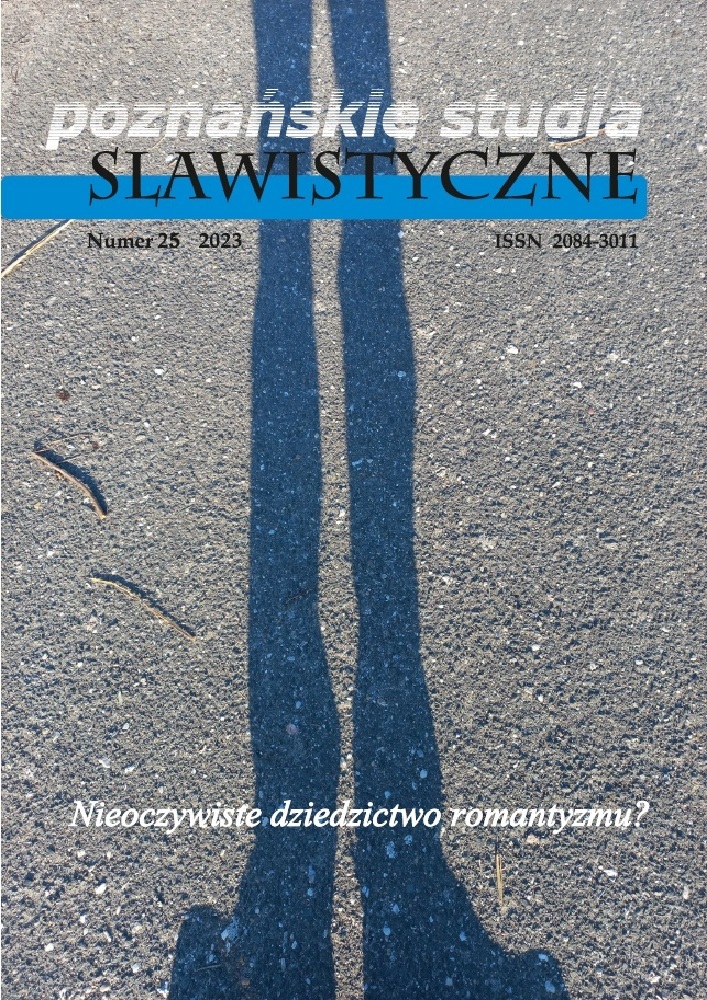Abstract
Croatian Romanticism uses a multitude of Judeo-Christian motifs. Kranjčević’s Moses enters into a direct dialogue with God, who is not only a distant transcendental authority, but also a concrete being who responds to the people’s cries. When Moses indicates dissatisfaction with his people’s slavery, God reciprocates with both words and actions. The objective of this article is to look at the
dialogues between man and God in the poem Moses in order to contribute to the research of the theme of communication between man and God in Croatian romantic poetry. The main subject of the poem is Moses, who is culturally more relevant for Judaism than for Christianity; his contribution in the Bible is connected to the struggle and active liberation from slavery. Unlike Christianity, Judaism affirms a revolutionary Messiah. In this poem, Moses is the prototype of a universal man in search of God, whereas communication is a prerequisite for solving individual and collective problems.
References
Billauer, B.P. (2014). Moses, the Tutmoses and the Exodus. „Social Science Research Network. DOI: https://doi.org/10.2139/ssrn.2429297
Dinescu, C. (2007). The Greek And Judeo-Christian Perspective On Anthropogenesis. „Studia Hebraica“, br. 7, str. 366–391. https://tinyurl.com/477ym8y5 (23.09.2023).
Donat, B. (2012). Prakseologija hrvatske književnosti II. Modernost i modernizam. Zaprešić: Fraktura.
Dorkin, M. (1987). Interpretacijski pristup poeziji Silvija Strahimira Kranjčevića. „Radovi. Razdio filoloških znanosti“, br. 26 (16), str. 231–248. DOI: https://doi.org/10.15291/radovifilo.1721
Eißfeldt, O., Fichtner, J., Gerleman, G., Hempel, J., Horst, F., Jepsen, A., Biblia Hebraica Stuttgartensia. (1977). Ur. D.W. Thomas. Stuttgart: Deutsche Bibelgesellschaft. https://tinyurl.com/db9fjeaw (23.09.2023).
Fališevac, D. (1980). Hrvatska srednjovjekovna proza. Književnopovijesne i poetičke osobine. Zagreb: Hrvatsko filološko društvo.
Flaker, A. (1976). Stilske formacije. Zagreb: Sveučilišna naklada Liber.
Frangeš, I. (1977). Krleža i Kranjčević. „Forum. Jugoslavenska akademija znanosti i umjetnosti“, br. 34 (9), str. 305–344.
Frangeš, I. (1996). Silvije Strahimir Kranjčević, izabrana djela. Zagreb: Matica hrvatska, str. 13–40.
Gesenius, W., Tregelles, S.P. (1857). Gesenius’s Hebrew and Chaldee Lexicon to the Old Testament Scriptures. Ur. i prev. S. Prideaux Tregelles. London: Samuel Bagster and Sons. https://archive.org/details/hebrewchaldeelex00geseuoft/mode/2up (23.09.2023).
Guralivu, V. (2021). Between Love and Judgement–The Sociological Side of Theology. „RAIS Journal for Social Sciences“, br. 5 (1), str. 79–83. https://www.ceeol.com/search/article-detail?id=981507 (23.09.2023).
Halivni, D. (1991). Peshat and Derash: Plain and Applied Meaning in Rabbinic Exegesis.Oxford: Oxford University Press on Demand. DOI: https://doi.org/10.1093/oso/9780195060652.001.0001
Jelčić, D. (1984). Kranjčević. Zagreb: Globus.
Jeruzalemska Biblija: Stari i Novi zavjet s uvodima i bilješkama iz „La Bible de Jérusalem”. (2007). Ur. A.Rebić, J. Fućak, B. Duda. Zagreb: Kršćanska sadašnjost.
Kahle, P. (1960). Die Aussprache des Hebräischen in Palästina vor der Zeit der tiberischen Masoreten. „Vetus Testamentum“, br. 10 (1), str. 375–385. DOI: https://doi.org/10.1163/156853360X00382
Konkić, S. (2010). Elementi Nietzscheove filozofije u poeziji Silvija Strahimira Kranjčevića. „Gradovrh-časopis za književno-jezična, društvena i prirodnoznanstvena pitanja“, br. 1 (7), str. 149–161. https://www.ceeol.com/search/article-detail?id=700623 (23.09.2023).
Koperwas, J. (online). Destroying Amalek: Removing Doubt & Insecurity. „Sefaria“. https://tinyurl.com/22uew59m (20.12.2022).
Kranjčević, S.S. (1997). Mojsije. U: Silvije Strahimir Kranjčević. Pjesme. Priredio V. Mataga. Ur. V.Rem. Vinkovci: Riječ, str. 86–91.
Krleža, M. (1953). Književnost danas. Hrvatska književna kritika. Svezak VI. Zagreb: Matica hrvatska, str. 195–228.
Leaney, A.R.C. (1966). Rule of Qumran and Its Meaning. London: SCM Press. Malamat, A. (2001). The Exodus: Egyptian Analogies. U: History of Biblical Israel. Ur. A.Malamat. Leiden: Brill. str. 57–67. DOI: https://doi.org/10.1163/9789004496194_008
Mataga, V. (1997). Predgovor. U: Silvije Strahimir Kranjčević. Pjesme. Priredio V. Mataga. Ur. V.Rem. Vinkovci: Riječ, str. 7–11.
Midrash Rabbah (1939). Exodus. Prev. S. M. Lehrman. London: Soncino, str. 404–405.
Mortensen, B.P. (2002). Pseudo-Jonathan’s temple, symbol of Judaism. U: Targum and scripture. Ur. P.V.M. Flesher. Leiden–Boston: Brill, str. 129–137. DOI: https://doi.org/10.1163/9789004494114_015
Moses, S., Wiskind-Elper, O. (1999). Gershom Scholem’s Reading of Kafka: Literary Criticism and Kabbalah. „New German Critique“, br. 77, str. 149–167. DOI: https://doi.org/10.2307/488525
Pavlović, B. (2003). Starac klesar i njegovi proroci: Ivan Mažuranić, Petar Preradović i S.S. Kranjčević. U: Ugodna pripovijest. Neobuhvatljivi eseji. Priredili J. Pandurić, G.Rem. Zagreb: Disput, str. 94–103.
Petrović, S. (1984). Obijest i gorčina, i stihom, kod Kranjčevića. „Umjetnost riječi, časopis za znanost o književnosti“, br. 28 (3), str. 212–225.
Robinson, G. (2008). Essential Torah: A Complete Guide to the Five Books of Moses. Schocken: Knopf Doubleday.
Schmaus, T. (2016). Nietzsches letzter Mensch als transhumanistische Dystopie. U: Nietzsche als Kritiker und Denker der Transformation. Ur. H. Heit, S. Thorgeirsdottir. Berlin–Boston: de Gruyter, str. 206–221. DOI: https://doi.org/10.1515/9783110473339-017
Scholem, G. (1971). Toward an Understanding of the Messianic Idea. U:G. Scholem. The messianic idea in Judaism and other essays on Jewish spirituality. New York: Schocken Books, str. 1–36.
Shabbat 89a. U: The William Davidson Talmud. Jerusalem: Koren-Steinsalz. https://tinyurl.com/267n4rka (20.12.2022).
Sharvit, G. (2021). Luria, Schelling, and Freud: From Zimzum to the Oedipus Complex. „The Journal of Jewish Thought and Philosophy“, br. 29 (2), str. 231–261. DOI: https://doi.org/10.1163/1477285X-12341336
Sifrei Devarim. U: Sefaria. https://tinyurl.com/mryxff53 (20.12.2022).
Spring, C., Shapiro, J. (2007). The enigma of the Joseph narrative. „Jewish Bible Quarterly“, br. 35 (4), str. 260–269. https://jbq.jewishbible.org/assets/Uploads/354/354_enigma.pdf (23.09.2023).
Šego, J., Volenik, A. (2012). Biblijski temelji u odabranim pjesmama Kranjčevića, Šimića i Ujevića. „Obnovljeni život“, br. 67 (3), str. 369–385. https://hrcak.srce.hr/85704 (23.09.2023).
Štrkalj Despot, K. (2009). Gospin plač iz Osorsko-hvarske pjesmarice. „Čakavska rič“, br. 37 (1–2). str. 123–145. https://hrcak.srce.hr/52868 (23.09.2023).
Užarević, J. (1991). Kompozicija lirske pjesme. Zagreb: Zavod za znanost o književnosti Filozofskog fakulteta u Zagrebu.
Yovel, Y. (1992). Spinoza and other heretics. The Marrano of Reason. Princeton: Princeton University Press.
License
Copyright (c) 2023 Paula Rem

This work is licensed under a Creative Commons Attribution 4.0 International License.

